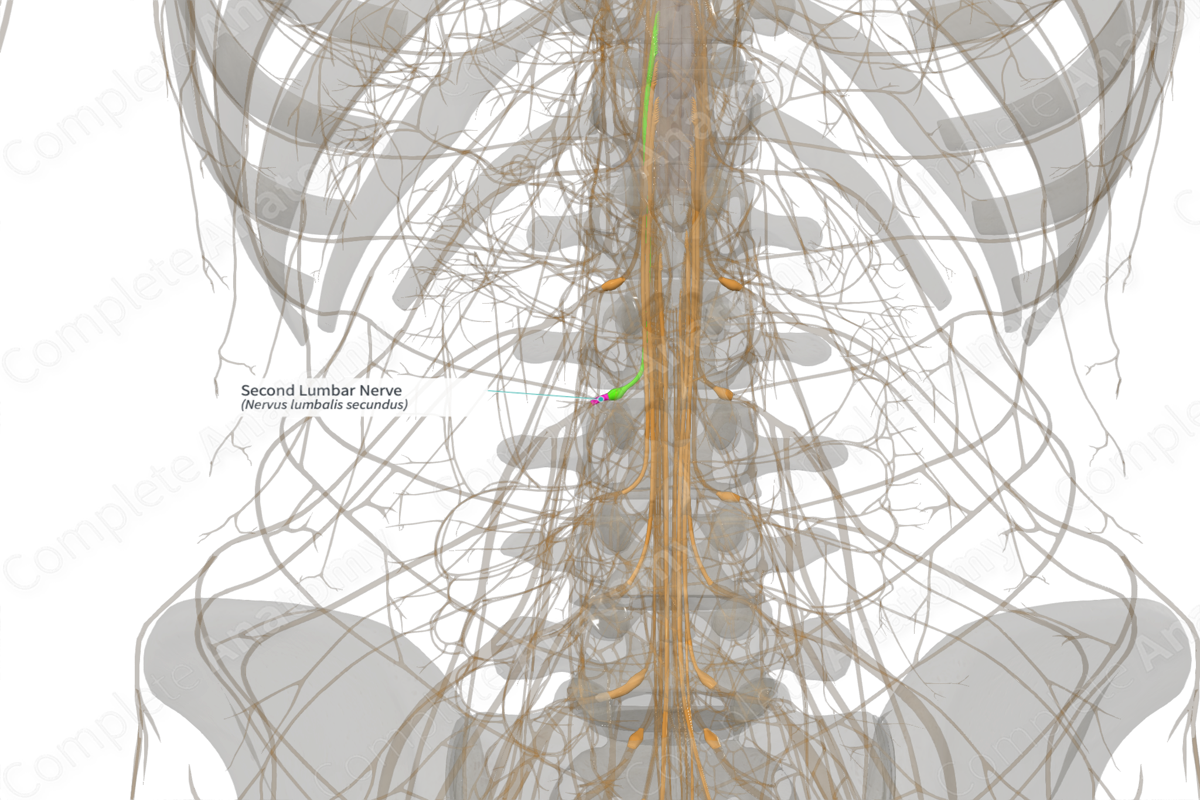
Quick Facts
Origin: The intervertebral foramen inferior to the second lumbar vertebra.
Course: Laterally to the lumbar plexus.
Branches: Posterior ramus, lateral cutaneous nerve of the thigh, genitofemoral, femoral, and obturator nerves.
Supply: Motor innervation to epaxial back muscles and skin of the back (lumbar levels), psoas, iliacus, pectineus, sartorius, quadriceps, gracilis, obturator externus, and adductor muscles. Sensory innervation to the skin of the lower back, lateral hip, and upper thigh. Sympathetic innervation to the hindgut, kidneys, and genitals.
Origin
The second lumbar nerve originates in, or just lateral, to the intervertebral foramen inferior to the second lumbar vertebra. Here, the anterior and posterior roots combine to form the first lumbar nerve proper.
Course
The second lumbar nerve gives off a posterior ramus running to the epaxial musculature and skin of the lower back, and an anterior ramus that runs inferior and laterally to the lumbar plexus.
Branches
The second lumbar nerve gives off a posterior ramus and contributes to four branches from the anterior ramus. These are part of the lumbar plexus and receive contributing fibers from additional lumbar levels. These include the genitofemoral nerve, lateral femoral cutaneous nerve (or lateral cutaneous nerve of thigh), femoral nerve, and obturator nerve.
Supplied Structures
The posterior ramus of the second lumbar nerve supplies the epaxial muscles of the lumbar region, including erector spinae and transversospinal muscles. In addition, it receives cutaneous innervation from the skin over the lower back.
The anterior ramus of the second lumbar nerve contributes to the lumbar plexus and the following nerves and their targets.
—Small branches innervate the iliopsoas muscle.
—The genitofemoral nerve arising from the first and second lumbar nerves is almost entirely sensory in females. It may innervate a few vestigial muscle fibers on the round ligament of the uterus. Sensory innervation is received from the mons pubis and labium majus (genital branch), and skin of the upper anterior thigh or femoral triangle (femoral branch).
—The lateral femoral cutaneous nerve contributes to both the second and third lumbar nerves and is only sensory. It innervates the anterior and lateral thigh from the inguinal ligament down to the knee.
—The femoral nerve arises from the second, third, and fourth lumbar nerves. It innervates psoas, iliacus, pectineus, sartorius, and quadriceps muscles (rectus femoris, vastus lateralis, vastus intermedius, and vastus medialis). It receives sensory innervation from the anterior and medial thigh.
—The obturator nerve arises from the second, third, and fourth lumbar nerves. It innervates the adductor muscles (gracilis, obturator externus, adductor longus, adductor brevis, and adductor magnus muscles). Sensory innervation from the obturator nerve is received from skin of the medial thigh.
Sympathetic fibers, which exit the first lumbar nerve via a white ramus communicans, travel to the sympathetic chain and target tissues in the hindgut, kidneys, and genital region.



